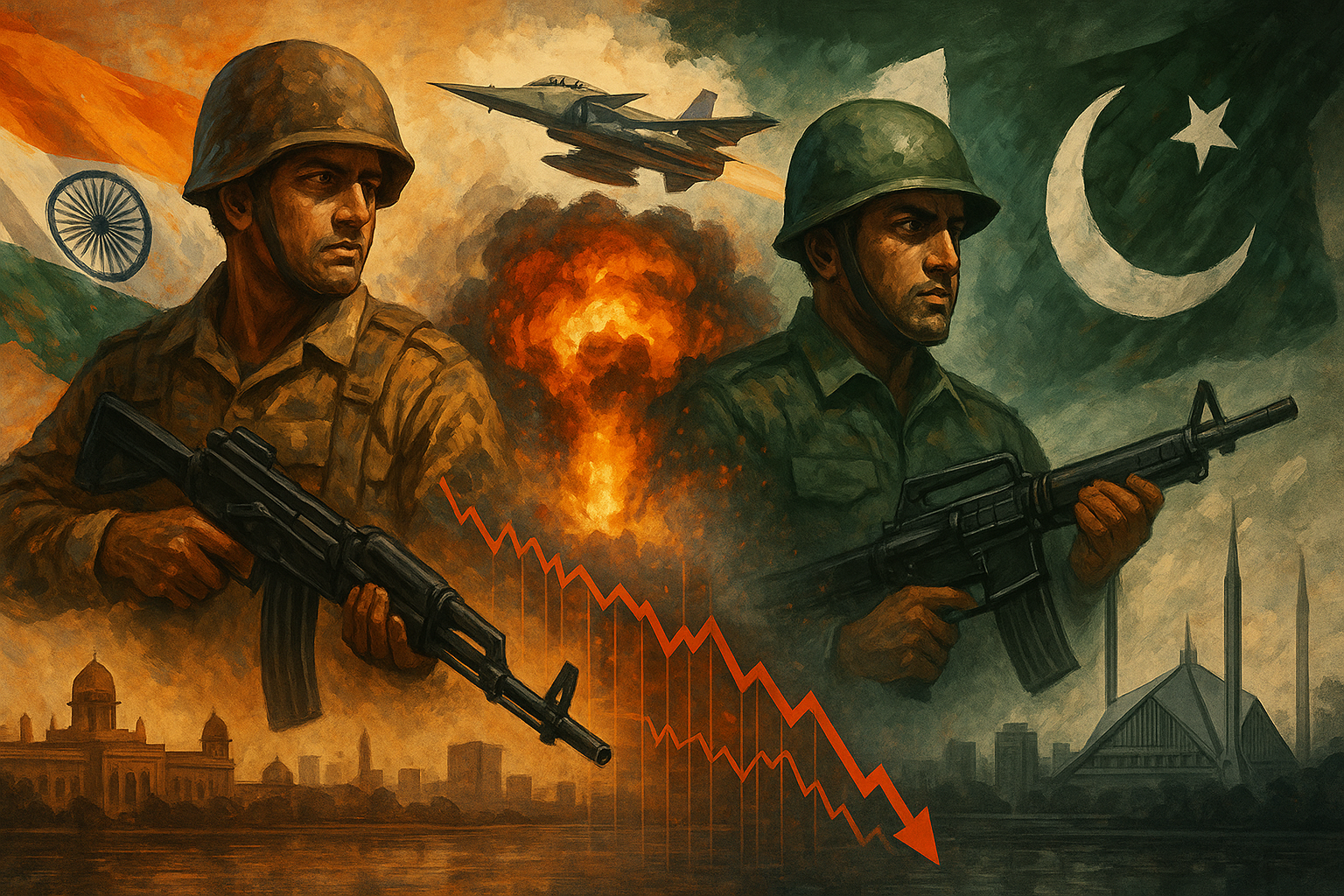In the past 24 hours the India-Pakistan crisis has lurched from a single-night air raid to a broad, information-soaked confrontation: New Delhi’s Operation Sindoor hit nine alleged militant sites on 7 May; Islamabad’s military replied with drones, artillery and a still-unverified claim that it shot down up to five Indian jets. Civilian deaths now exceed 40 on both sides, financial markets have wobbled, and diplomatic phone-lines from Washington to Riyadh are crackling. The next move is likely a calibrated show of force rather than a march to full-scale war, but mis-calculation remains the hardest variable to price.
1. What actually happened (8–9 May)
1.1 Indian strike and official narrative
- 02:15 on 7 May: Indian Air Force Rafales and Su-30s hit sites in Bahawalpur, Muridke, Muzaffarabad and two LoC villages, citing the 22 April Pahalgam massacre of 26 Hindu tourists as causus belli. Nine “terror infrastructure” targets were filmed and released to the press. (Reuters)
- Prime Minister Narendra Modi framed the operation as “focused, measured, non-escalatory”. (Swarajya)
1.2 Pakistan’s response and the fog of claims
- Islamabad denounced the strikes as an “act of war”; Prime Minister Shehbaz Sharif promised to “avenge each drop of blood”. (Al Jazeera)
- Pakistan’s Inter-Services Public Relations said J-10C fighters downed five Indian aircraft and destroyed an Indian brigade HQ—claims India rejects; U.S. officials confirm only two shoot-downs. (Reuters, Dawn)
- Fact-checkers show viral photos of “downed Rafales” are from earlier crashes; doctored TV clips and recycled training-jet footage amplified disinformation. (www.ndtv.com, Alt News, BOOM)
1.3 Current military posture
- Overnight (9 May) skirmishes: 25 drones reportedly shot down over Pakistan; India says 16 were Iranian-made Shahed copies supplied via proxies. (The Washington Post)
- Artillery exchanges killed at least 12 civilians in Poonch and Uri; black-outs ordered in Chandigarh, Ambala and parts of Lahore. (The Indian Express, The Economic Times)
- Hotlines between both National Security Advisers and Directors-General of Military Operations have reopened, but LoC cease-fire of 2021 is “functionally suspended”. (Dawn)
2. Economic and market fallout
| Metric | Last 24 h move | Why it matters |
|---|---|---|
| INR NDF | -1.4 % to ₹ 84.65/$ | RBI intervention cap needed (Reuters) |
| KSE-100 | -3.4 % | foreign outflows, IMF review risk (Reuters) |
| Moody’s flash note | warns of “credit-negative shock” to Pakistan, fiscal drag on India | defence outlays + lost tourism revenue (Reuters) |
| IPL suspension | estimated ₹ 5.8 bn TV-ad loss | dents consumer-demand sentiment (Financial Times) |
| Cross-LoC trade | halted (≈ $160 m/yr) | rural border livelihoods hit (The Guardian) |
Bottom line: India’s $3.7 trn economy can absorb a brief shock; Pakistan’s $370 bn, IMF-supervised economy cannot. Prolongation risks rupee depreciation, petrol price spikes and budget-busting defence bills on both sides.
3. Human cost and social climate
- Civilian toll: 31 killed in Punjab & AJK, 12 in J-K border villages, dozens injured. (The Guardian, The Indian Express)
- Infrastructure: two mosques, three schools, a power sub-station destroyed; 900 schools closed along LoC. (The Guardian)
- Information war: nationalist TV and bot-driven campaigns (#OperationRevenge, #CrushPakistan) spike across X/Twitter and Facebook, amplifying fake visuals. (AP News, Alt News)
4. Likely trajectories (next 2-4 weeks)
| Scenario | Probability | Drivers |
|---|---|---|
| Controlled escalation (limited tit-for-tat strikes, back-channel cease-fire) | ≈ 60 % | nuclear shadow, U.S./Gulf mediation, IMF leverage |
| Diplomatic freeze, no further strikes | 25 % | domestic optics satisfied, back-channel talks hold |
| Run-away escalation (extended air campaign, possible ground probes) | 15 % | mis-reading of intent, civilian mass-casualty trigger |
Strategic analysts in Washington and London note the absence of new red-line protocols since 2019, raising accidental-war risk. (The Washington Post, Financial Times)
5. De-escalation and trust-building agenda
5.1 Immediate steps
- DGMO joint verification: share UAV imagery to confirm no force build-ups within 5 km of LoC.
- Humanitarian corridor: UAE- and OIC-facilitated relief lane for medical evacuations from Muzaffarabad and Uri.
- UN-backed cease-fire monitors: expand UNMOGIP mandate to include drone incidents. (The Express Tribune)
5.2 Economic confidence measures
- Reopen Wagah-Attari route for perishables; synchronise tariff suspension on 15 essential medicines.
- Resume Indus Waters Treaty joint inspection postponed since 2023. (Financial Times)
5.3 Civil-society & media
- Fund cross-border fact-checking consortium; launch joint media-literacy campaigns to counter disinformation. Dawn’s editorial explicitly warns that Bollywood-style jingoism is fuelling public pressure. (Dawn)
6. Calling the Modi government to account
| Lever | How to use it |
|---|---|
| Judicial review | Public-interest litigation invoking Article 21 (right to life) can demand a proportionality audit of Operation Sindoor, echoing the post-Balakot petitions of 2019. |
| Right-to-Information | Opposition MPs and think-tanks can file RTI requests for satellite damage assessments, civilian-casualty studies and legal opinions tendered before the strike. |
| Parliamentary oversight | Force a special joint sitting of Lok Sabha and Rajya Sabha defence committees to publish a redacted strike brief. |
| Investor & ESG pressure | PRI-signatory funds can question upcoming Indian sovereign-bond issuances over conflict-risk disclosure. |
| Global media scrutiny | Encourage international outlets (Guardian, Washington Post) already critical of normalising warfare to run casualty audits and spotlight civilian voices. (The Guardian, The Washington Post) |
7. Conclusion
The crisis sits in a “dangerous yet containable” window: both militaries appear to be signalling deterrence, not invasion. History shows India and Pakistan usually climb down under external pressure and mutual exhaustion, but the disinformation cloud, rapid drone warfare and domestic politics make that descent steeper. Swift transparency, third-party mediation and small but symbolic economic reopenings are the surest off-ramps—while rigorous institutional checks are the best way to hold the Modi government (and its Pakistani counterpart) to their professed “measured” posture.



